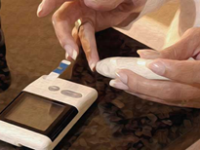Differences Between Type 1 and 2
 In general, people with diabetes either have a total lack of insulin (type 1 diabetes) or they have too little insulin or cannot use insulin effectively (type 2 diabetes).
In general, people with diabetes either have a total lack of insulin (type 1 diabetes) or they have too little insulin or cannot use insulin effectively (type 2 diabetes).
Type 1 diabetes (formerly called juvenile-onset or insulin-dependent diabetes), accounts for 5 to 10 out of 100 people who have diabetes. In type 1 diabetes, the body’s immune system destroys the cells that release insulin, eventually eliminating insulin production from the body. Without insulin, cells cannot absorb sugar (glucose), which they need to produce energy.
Type 2 diabetes (formerly called adult-onset or non-insulin-dependent diabetes) can develop at any age. It most commonly becomes apparent during adulthood. But type 2 diabetes in children is rising. Type 2 diabetes accounts for the vast majority of people who have diabetes-90 to 95 out of 100 people. In type 2 diabetes, the body isn’t able to use insulin the right way. This is called insulin resistance. As type 2 diabetes gets worse, the pancreas may make less and less insulin. This is called insulin deficiency.
Type 1 diabetes
- Symptoms usually start in childhood or young adulthood. People often seek medical help, because they are seriously ill from sudden symptoms of high blood sugar.
- Episodes of low blood sugar level (hypoglycemia) are common.
- It cannot be prevented.
Type 2 diabetes
- The person may not have symptoms before diagnosis. Usually the disease is discovered in adulthood, but an increasing number of children are being diagnosed with the disease.
- There are no episodes of low blood sugar level, unless the person is taking insulin or certain diabetes medicines.
- It can be prevented or delayed with a healthy lifestyle, including maintaining a healthy weight, eating sensibly, and exercising regularly.
How are they alike?
Both types of diabetes greatly increase a person’s risk for a range of serious complications. Although monitoring and managing the disease can prevent complications, diabetes remains the leading cause of blindness and kidney failure. It also continues to be a critical risk factor for heart disease, stroke, and foot or leg amputations.





